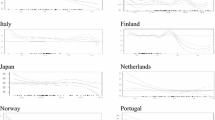Abstract
Real exchange rate variance decompositions indicate that only a small fraction of real exchange rate movements can be attributed to changes in the relative price between traded and non-traded goods. This paper argues that those exercises, by ignoring the nature of the shocks behind real exchange rate changes, may be inadequate to measure the relative importance of non-traded goods prices. Instead, it proposes using a structural vector autoregression (SVAR) model to study the effects of shocks to the relative supply and relative demand for non-traded goods on the real exchange rate. The SVAR model is identified via long-run restrictions and is estimated for a group of advanced economies. The results indicate that for some countries, relative supply shocks can be a significant source of real exchange rate fluctuations.




Similar content being viewed by others
Notes
Engel (1999) decomposed the real exchange rate mean square error rather than its variance because his data were not detrended.
Other authors have used the CPI for goods or the Producer Price Index as a proxy for traded goods prices. The advantage of using an average of export and import prices is that they exclude non-traded distribution and retail costs.
The sample period varies by country due to data availability.
The lag tests performed include the sequential modified likelihood ratio statistic, the final prediction error, the Akaike information criterion, the Schwartz information criterion, and the Hannan-Quinn information criterion.
This identification strategy was first proposed by Blanchard and Quah (1989). In their model, aggregate demand and aggregate supply shocks are identified by assuming that only the latter can have a permanent effect on real GDP. For a recent discussion on this methodology, see Lütkepohl and Velinov (2016).
Fifteen additional identifying restrictions were obtained from the estimated variance-covariance matrix of the reduced-form innovations.
For example, m 32 = 0 means that the cumulative effect of a shock to variable 2 (relative quantity) on variable 3 (relative price) is zero in the long run.
A similar identifying restriction is used in Drine and Rault (2009).
These IRFs are calculated using the model with one lag.
The real exchange rate is defined so that a decline means an appreciation.
Impulse-response functions for the model with six lags (not shown) also indicate a delayed effect of relative supply shocks on the real exchange rate.
References
Balassa, B. (1964). The purchasing power parity doctrine: A reappraisal. Journal of Political Economy, 72(6), 584–596.
Balke, N., Ma, J., & Wohar, M. (2013). The contribution of economic fundamentals to movements in exchange rates. Journal of International Economics, 90(1), 1–16.
Berka, M., Devereux, M., & Engel, C. (2012). Real exchange rate adjustment in and out of the Eurozone. American Economic Review, 102(3), 179–185.
Blanchard, O., & Quah, D. (1989). The dynamic effects of aggregate demand and supply disturbances. American Economic Review, 79(4), 655–673.
Burstein, A., Eichenbaum, M., & Rebelo, S. (2006). The importance of Nontradeable goods prices in cyclical real exchange rate fluctuations. Japan and the World Economy, 18(3), 247–253.
Chari, V., Kehoe, P., & McGrattan, E. (2002). Can sticky price models generate volatile and persistent real exchange rates? Review of Economic Studies, 69(3), 533–563.
Clarida, R., & Gali, J. (1994). Sources of real exchange rate fluctuations: How important are nominal shocks? Carnegie-Rochester Conference Series on Public Policy, 41, 1–56.
Drine, I., & Rault, C. (2009). Une Analyse Économétrique des Sources de Fluctuations du Taux de Change Réel dans Trois Pays en Dévelopment: Le Cas du Maroc, des Philippines et de l’Uruguay. Revue Économique, 60(6), 1421–1453.
Engel, C. (1999). Accounting for U.S. Real exchange rate changes. Journal of Political Economy, 107(3), 507–538.
International Monetary Fund (IMF) (2014). Data retrieved from Wharton Research Data Services (https://wrds-web.wharton.upenn.edu/wrds/) on October 28, 2014.
Lütkepohl, H., & Velinov, A. (2016). Structural vector Autoregressions: Checking identifying long-run restrictions via Heteroskedasticity. Journal of Economic Surveys, 30(2), 377–392.
Obstfeld, M., & Rogoff, K. (1996). Foundations of international macroeconomics. Cambridge, MA: MIT Press.
Organisation for Economic Co-operation and Development (OECD) (2014). Data retrieved from OECD.Stat (http://stats.oecd.org/) on October 27, 2014.
Ouyang, A., & Rajan, R. (2013). Real exchange rate fluctuations and the relative importance of Nontradables. Journal of International Money and Finance, 32, 844–855.
Author information
Authors and Affiliations
Corresponding author
Rights and permissions
About this article
Cite this article
Azcona, N. Non-Traded Goods and Real Exchange Rate Fluctuations: A Structural VAR Analysis. Int Adv Econ Res 23, 137–148 (2017). https://doi.org/10.1007/s11294-017-9635-y
Published:
Issue Date:
DOI: https://doi.org/10.1007/s11294-017-9635-y




